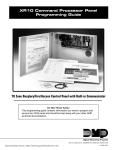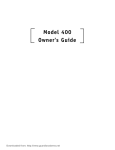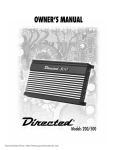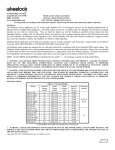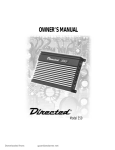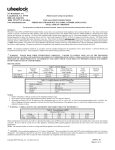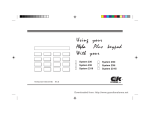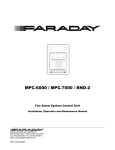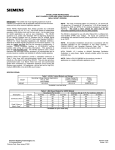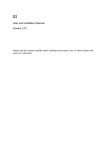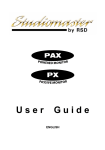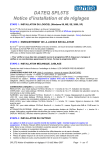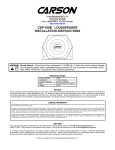Download DMP Electronics P83848 User's Manual
Transcript
,167$//$7,21#3;6;7; ;56#$8',%/(#+251#6752%( Thank you for using our products. INSTALLATION INSTRUCTIONS AUDIBLE HORN STROBE TWO WIRE APPLIANCES (WALL MOUNT VERSIONS) Use this product according to this instruction manual. Please keep this instruction manual for future reference. GENERAL: DMP’s Audible Horn Strobe Appliances require only 2-wires for operation of the horn and strobe appliance and provide a selectable continuous or Code 3 Horn tone and continuous strobe when connected directly to the Fire Alarm Control Panel (FACP). They can also provide a synchronized Code 3 horn tone and synchronized strobe when used in conjunction with a Sync Module (831) or Dual Sync Module (832). They are the ideal choice for applications where the audible silence feature is required. The Audible Horn Strobe Appliances are UL Listed under Standard 1971 for Signaling Devices for the Hearing Impaired and UL Standard 464 for Audible Signal Appliances. The 15 candela wall mounted strobes are listed at 15 candela under UL Standard 1971 and meet 75 candela intensity on axis with low current draw. They are listed for indoor use only and equipped with a Horn Strobe Mounting Plate (823) that can be mounted to single-gang, double-gang, 4” backbox, 100mm European backbox or SHBB surface backbox (See Mounting Options). These strobe models are Listed for wall mounting only. The Audible Horn Strobe Appliances use a Xenon flashtube with solid state circuitry enclosed in a rugged Lexan lens to provide maximum visibility and reliability for effective visible signaling. Audible Horn Strobe Appliances can be field set for High (HI) or Low (LO) dBA sound output. These strobe models are designed for use with either filtered DC (VDC) or unfiltered Full-Wave-Rectified (VRMS) input voltage. All inputs are polarized for compatibility with standard reverse polarity supervision of circuit wiring by a FACP. NOTE: All CAUTIONS and WARNINGS are identified by the symbol . All warnings are printed in bold capital letters WARNING: PLEASE READ THESE INSTRUCTIONS CAREFULLY BEFORE USING THIS PRODUCT. FAILURE TO COMPLY WITH ANY OF THE FOLLOWING INSTRUCTIONS, CAUTIONS AND WARNINGS COULD RESULT IN IMPROPER APPLICATION, INSTALLATION AND/OR OPERATION OF THESE PRODUCTS IN AN EMERGENCY SITUATION, WHICH COULD RESULT IN PROPERTY DAMAGE AND SERIOUS INJURY OR DEATH TO YOU AND/OR OTHERS. SPECIFICATIONS: Models 803 Table 1: UL Ratings Nominal Rated Voltage Voltage Range (VDC/VRMS) (VDC/VRMS) 12 10.5-15.6 Strobe Candela (cd) 15* * 15cd models are UL Listed for 15cd and meet 75cd on axis. Description Continuous Horn Code 3 Horn Volume Low High Low High Table 2A: dBA Sound Output Reverberant Per UL 464 10.5VDC 12.0VDC 15.6VDC 73* 76 76 82 82 85 67* 70* 70* 76 76 79 10.5VDC 82 87 82 87 Anechoic dBA 12.0VDC 15.6VDC 84 86 89 91 84 86 89 91 2841 E. Industrial Drive, Springfield, MO 65802-6310 800-641-4282 WARNING: AUDIBLE HORN STROBE APPLIANCES SET ON LOW dBA DO NOT MEET THE 75dBA MINIMUM UL REVERBERANT SOUND LEVEL REQUIRED FOR PUBLIC MODE FIRE PROTECTION SERVICE (NOTED BY * Sheet 1 of 7 Downloaded from: http://www.guardianalarms.net IN TABLE 1). THIS SETTING IS ACCEPTABLE ONLY FOR GENERAL SIGNALING (NON-FIRE ALARM) USE. USE THE “HIGH” dBA SETTING WITH THIS TONE FOR PUBLIC MODE SERVICE. NOTES: 1. Strobes will produce 1 flash per second over the listed voltage range. 2. Anechoic dBA is measured on axis in a non-reflective (free field) test room using fast meter response. For peak dBA (measured with peak meter response), add 5dBA to anechoic values as shown in Table 2. Reverberant dBA is a minimum UL rating based on sound pressure measurements in a reverberant test room. 3. All models are UL Listed for indoor use with a temperature range of +32oF to +120oF (0oC to +49oC) and maximum humidity of 85% RH. Check the minimum and maximum output of the power supply and standby battery and subtract the voltage drop from the circuit wiring resistance to determine the applied voltage to the signaling appliance. WARNING: ALTHOUGH UL TESTING HAS VERIFIED THAT THESE PRODUCTS FUNCTION EVEN AT 80% OF THEIR MINIMUM RATING AND 110% OF THEIR MAXIMUM RATING, DMP STRONGLY RECOMMENDS THAT THE VOLTAGE APPLIED TO THESE PRODUCTS BE WITHIN THEIR RATED VOLTAGE RANGE. THE APPLICATION OF IMPROPER VOLTAGE MAY RESULT IN DEGRADED OPERATION OR DAMAGE TO THESE PRODUCTS, WHICH COULD RESULT IN PROPERTY DAMAGE AND SERIOUS INJURY OR DEATH TO YOU AND/OR OTHERS. Voltage 10.5VDC 12.0VDC 15.6VDC 10.5VRMS 12.0VRMS 15.6VRMS Table 3: Current Ratings Current Ratings (AMPS) with Hi dBA Setting Current Ratings (AMPS) with Low dBA Setting Rated Average Rated Peak Rated Inrush Rated Average Current Current** Current*** Current (Low) *15cd *15cd *15cd *15cd 0.215 0.510 0.225 0.210 0.184 0.520 0.255 0.179 0.140 0.530 0.340 0.135 0.240 0.520 0.320 0.235 0.225 0.530 0.370 0.220 0.205 0.540 0.485 0.200 * 15cd models are UL Listed at 15 candela and meet 75cd on axis. ** The time duration for the peak current is 100 microseconds. *** The time duration for the inrush current is 4 milliseconds. WARNING: MAKE SURE THAT THE TOTAL AVERAGE CURRENT, TOTAL PEAK CURRENT AND TOTAL INRUSH CURRENT REQUIRED BY ALL APPLIANCES THAT ARE CONNECTED TO THE SYSTEM’S PRIMARY AND SECONDARY POWER SOURCES, SIGNALING CIRCUITS, SYNC MODULE AND DUAL SYNC MODULE DO NOT EXCEED THE POWER SOURCES’ RATED CAPACITY OR THE CURRENT RATINGS OF ANY FUSES ON THE CIRCUITS TO WHICH THESE APPLIANCES ARE WIRED. OVERLOADING POWER SOURCES OR EXCEEDING FUSE RATINGS COULD RESULT IN LOSS OF POWER AND FAILURE TO ALERT OCCUPANTS DURING AN EMERGENCY, WHICH COULD RESULT IN PROPERTY DAMAGE AND SERIOUS INJURY OR DEATH TO YOU AND/OR OTHERS. When calculating the total average, peak and inrush currents: Use Table 3 to determine the highest value of “Rated Average Current” for an individual strobe (across the expected operating voltage range of the strobe), and use Table 3 to determine the highest value of “Rated Inrush Current” or “Rated Peak Current” (whichever is higher) of an individual strobe (across the expected voltage range of the strobe), then multiply these values by the total number of strobes; be sure to add the currents for any other appliances, including audible signaling appliances, powered by the same source and include any required safety factors. If the inrush current or peak current exceeds the power supplies’ inrush capacity, the output voltage provided by the power supplies may drop below the listed voltage range of the appliances connected to the supply and the voltage may not recover in some types of power supplies. For example, an auxiliary power supply that lacks filtering at its output stage (either via lack of capacitance and/or lack of battery backup across the output) may exhibit this characteristic. CAUTION: Audible Horn Strobe are not designed to be used on coded systems in which the applied voltage is cycled on and off. P83848 A Sheet 2 of 7 LIGHT DISTRIBUTION PER UL 1971: Angle (in deg.) 0 5 10 15 20 25 30 35 40 45 50 55 60 65 70 75 80 85 90 UL Min. 15.0 13.5 13.5 13.5 13.5 13.5 11.3 11.3 11.3 11.3 8.3 6.8 6.0 5.3 5.3 4.5 4.5 3.8 3.8 Table 4: Horizontal and Vertical Plane Horizontal Typ. 15cd* UL Min. 94 15.0 93 13.5 88 13.5 87 13.5 85 13.5 80 13.5 75 13.5 71 9.8 62 6.9 52 5.1 35 4.0 32 3.3 34 2.7 27 2.4 19 2.3 11 2.0 9 1.8 10 1.8 10 1.8 Vertical Typ. 15cd* 94 83 30 19 17 16 15 12 11 10 9 9 9 9 10 10 9 9 9 * 15cd models are UL Listed for 15cd and meet 75cd on axis. WARNING: WHEN INSTALLING STROBES IN AN OPEN OFFICE OR OTHER AREAS CONTAINING PARTITIONS OR OTHER VIEWING OBSTRUCTIONS, SPECIAL ATTENTION SHOULD BE GIVEN TO THE LOCATION OF THE STROBES SO THAT THEIR OPERATING EFFECT CAN BE SEEN BY ALL INTENDED VIEWERS, WITH THE INTENSITY, NUMBER, AND TYPE OF STROBES BEING SUFFICIENT TO MAKE SURE THAT THE INTENDED VIEWER IS ALERTED BY PROPER ILLUMINATION, REGARDLESS OF THE VIEWER'S ORIENTATION. FAILURE TO DO SO COULD RESULT IN PROPERTY DAMAGE AND SERIOUS INJURY OR DEATH TO YOU AND/OR OTHERS. WARNING: THE AUDIBLE HORN STROBE APPLIANCES MUST BE FIELD SET TO THE DESIRED TONE AND dBA SOUND OUTPUT LEVEL BEFORE THEY ARE INSTALLED. THIS IS DONE BY PROPERLY INSERTING JUMPER PLUGS IN ACCORDANCE WITH THESE INSTRUCTIONS. INCORRECT SETTINGS WILL RESULT IN IMPROPER PERFORMANCE, WHICH COULD RESULT IN PROPERTY DAMAGE AND SERIOUS INJURY OR DEATH TO YOU AND/OR OTHERS. SOUND OUTPUT (SPL) SETTINGS: NOTE: The Code 3 Horn incorporates the temporal pattern (1/2 second on, 1/2 second off, 1/2 second on, 1/2 second off, 1/2 second on, 1-1/2 off and repeat) specified by ANSI/NFPA for standard emergency evacuation signaling. The Code 3 Horn should be used only for fire evacuation signaling and not for any other purpose. Figure 1: Showing Location of Jumper Plug Factory setting is on High dB and Code 3 P83848 A Sheet 3 of 7 Figure 2: Jumper plug settings for High dB and Code 3. Figure 3: Jumper plug settings for Low dB and Continuous Horn. Figure 4: Jumper plug settings for Low dB and Code 3. Figure 5: Jumper plug settings for High dB and Continuous Horn. (Use needle nose pliers to pull and properly set the jumper plugs.) No jumper plugs are needed for Continuous Horn and low dB settings. However, it is recommended that the jumper plug be retained in the unit for future use (if needed) as shown in Figure 3, 4 and 5. Note: The Audible Horn Strobe must be set for code 3 when used with the sync module. WIRING INFORMATION: Figure 6. When the sync module is used, the audible tone will be the code 3 sound only. Refer to Sync Module installation instruction sheets Sync Module (P83850) and Dual Sync Module (P83844) for additional information. Figure 7. 1) Audible Horn Strobe Appliances have in-out wiring terminals that accepts two #12 to 18 American Wire Gauge (AWG) wires at each screw terminal. Strip leads 3/8” inches for connection to screw terminals. 2) Break all in-out wire runs on supervised circuit supervision as shown in Figure 7. The polarity shown in the wiring diagrams is for the operation of the appliances. The polarity is reversed by the FACP during supervision. P83848 A Sheet 4 of 7 MOUNTING OPTIONS: CAUTION: The following figures show the maximum number of field wires (conductors) that can enter the backbox used with each mounting option. If these limits are exceeded, there may be insufficient space in the backbox to accommodate the field wires and stresses from the wires could damage the product. Although the limits shown for each mounting option comply with the National Electrical Code (NEC), DMP recommends use of the largest backbox option shown and the use of approved stranded field wires, whenever possible, to provide additional wiring room for easy installation and minimum stress on the product from wiring. MOUNTING PROCEDURES: P83848 A Sheet 5 of 7 CAUTION: Check that the installed product will have sufficient clearance and wiring room prior to installing backboxes and conduit, especially if sheathed multiconductor cable or 3/4" conduit fittings are used. 1. Audible Horn Strobe models have an integrated 823 Mounting Plate. 2. The 823 Mounting Plate must be oriented correctly when it is mounted to the backbox. Turn the 823 Mounting Plate so that the arrow below the word “Top” points to the top side of the 823 Mounting Plate. 3. Audible Horn Strobe models can be flush mounted to a standard single-gang backbox (Figure A), 4” or 100mm backbox (Figure B) or double-gang backbox (Figure C). Audible Horn Strobe models can also be surface mounted to a 4” or 100mm backbox (Figure B), double-gang backbox (Figure C) or the SHBB (Figure D). 4. Mount the 823 Mounting Plate first to the backbox. Next slide the 823 Beauty Plate over the 823 Mounting Plate until the 2 side snaps of the 823 Beauty Plate engage with the 823 Mounting Plate. 5. The 823 Beauty Plate can be removed from the strobe assembly once engaged. First, gently insert a screwdriver into one of the slots located on the side edges of the Audible Horn Strobe Beauty Plate. Second, gently pull away from the wall with the inserted screwdriver to disengage the snap. Third, repeat the first and second steps for the second slot. Finally, gently lift the 823 Beauty Plate away from the 823 Mounting Plate. 6. Mounting hardware for each mounting option is supplied. 7. Conduit entrances to the backbox should be selected to provide sufficient wiring clearance for the installed product. 8. When terminating field wires, do not use more lead length than required. Excess lead length could result in insufficient wiring space for the signaling appliance. 9. Use care and proper techniques to position the field wires in the backbox so that they use minimum space and produce minimum stress on the product. This is especially important for stiff, heavy gauge wires and wires with thick insulation or sheathing. 10. Do not pass additional wires (used for other than the signaling appliance) through the backbox. Such additional wires could result in insufficient wiring space for the signaling appliance. CAUTION: If these appliances are operated within 15 inches of a person's ear, they can produce a sound pressure level that exceeds the maximum 120dBA permitted by ADA and OSHA rules. Exposure to such sound levels can result in damage to a person's hearing. FIELD OF VIEW, UNDER CERTAIN CIRCUMSTANCES, MIGHT INDUCE A PHOTO-SENSITIVE RESPONSE IN PERSONS WITH EPILEPSY. STROBE REFLECTIONS IN A GLASS OR MIRRORED SURFACE MIGHT ALSO INDUCE SUCH A RESPONSE. TO MINIMIZE THIS POSSIBLE HAZARD, DMP STRONGLY RECOMMENDS THAT THE STROBES INSTALLED SHOULD NOT PRESENT A COMPOSITE FLASH RATE IN THE FIELD OF VIEW WHICH EXCEEDS FIVE (5) Hz AT THE OPERATING VOLTAGE OF THE STROBES. DMP ALSO STRONGLY RECOMMENDS THAT THE INTENSITY AND COMPOSITE FLASH RATE OF INSTALLED STROBES COMPLY WITH LEVELS ESTABLISHED BY APPLICABLE LAWS, STANDARDS, REGULATIONS, CODES AND GUIDELINES. NOTE: NFPA 72/ANSI 117.1 conform to ADAAG Equivalent Facilitation Guidelines in using fewer, higher intensity strobes within the same protected area. CAUTION: Check the installation instructions of the manufacturers of other equipment used in the system for any guidelines or restrictions on wiring and/or locating Notification Appliance Circuits (NAC) and notification appliances. Some system communication circuits and/or audio circuits, for example, may require special precautions to assure electrical noise immunity (e.g. audio crosstalk). NOTE: This equipment has been tested and found to comply with the limits for a Class B digital appliance, pursuant to Part 15 of the FCC Rules. These limits are designed to provide reasonable protection against harmful interference in residential installation. This equipment generates, uses and can radiate radio frequency energy and, if not installed and used in accordance with the instructions, may cause harmful interference to radio communications. However, there is no guarantee that interference will not occur in a particular installation. If this equipment does cause harmful interference to radio or television reception, which can be determined by turning the equipment off and on, the user is encouraged to try to correct the interference by one or more of the following measures: 1) Reorient or relocate the receiving antenna, 2) Increase the separation between the equipment and receiver, 3) Connect the equipment into an outlet on a circuit different from that to which the receiver is connected, and 4) Consult the dealer or an experienced radio/TV technician for help. P83848 A Sheet 6 of 7 IMPORTANT: READ SEPARATE "GENERAL INFORMATION" SHEET FOR INFORMATION ON THE PLACEMENT, LIMITATIONS, INSTALLATION, FINAL CHECKOUT, AND PERIODIC TESTING OF NOTIFICATION APPLIANCES. Limited Warranty These products must be used within their published specifications and must be PROPERLY specified, applied, installed, operated, maintained and operationally tested in accordance with these instructions at the time of installation and at least twice a year or more often and in accordance with local, state and federal codes, regulations and laws. Specification, application, installation, operation, maintenance and testing must be performed by qualified personnel for proper operation in accordance with all of the latest National Fire Protection Association (NFPA), Underwriters' Laboratories (UL), Underwriters' Laboratories of Canada (ULC), National Electrical Code (NEC), Occupational Safety and Health Administration (OSHA), local, state, county, province, district, federal and other applicable building and fire standards, guidelines, regulations, laws and codes including, but not limited to, all appendices and amendments and the requirements of the local authority having jurisdiction (AHJ). These products when properly specified, applied, installed, operated, maintained and operationally tested as provided above are warranted against mechanical and electrical defects for a period of three years from date of manufacture (as determined by date code). Correction of defects by repair or replacement shall be at manufacturer's sole discretion and shall constitute fulfillment of all obligations under this warranty. THE FOREGOING LIMITED WARRANTY SHALL IMMEDIATELY TERMINATE IN THE EVENT ANY PART NOT FURNISHED BY THE MANUFACTURER IS INSTALLED IN THE PRODUCT. THE FOREGOING LIMITED WARRANTY SPECIFICALLY EXCLUDES ANY SOFTWARE REQUIRED FOR THE OPERATION OF OR INCLUDED IN A PRODUCT. THE MANUFACTURER MAKES NO REPRESENTATION OR WARRANTY OF ANY OTHER KIND, EXPRESS, IMPLIED OR STATUTORY WHETHER AS TO MERCHANTABILITY, FITNESS FOR A PARTICULAR PURPOSE OR ANY OTHER MATTER. USERS ARE SOLELY RESPONSIBLE FOR DETERMINING WHETHER A PRODUCT IS SUITABLE FOR THE USER'S PURPOSES, OR WHETHER IT WILL ACHIEVE THE USER'S INTENDED RESULTS. THERE IS NO WARRANTY AGAINST DAMAGE RESULTING FROM MISAPPLICATION, IMPROPER SPECIFICATION, ABUSE, ACCIDENT OR OTHER OPERATING CONDITIONS BEYOND MANUFACTURER'S CONTROL. SOME OF THE MANUFACTURER’S PRODUCTS CONTAIN SOFTWARE. WITH RESPECT TO THOSE PRODUCTS, THE MANUFACTURER DOES NOT WARRANTY THAT THE OPERATION OF THE SOFTWARE WILL BE UNINTERRUPTED OR ERROR-FREE OR THAT THE SOFTWARE WILL MEET ANY OTHER STANDARD OF PERFORMANCE, OR THAT THE FUNCTIONS OR PERFORMANCE OF THE SOFTWARE WILL MEET THE USER'S REQUIREMENTS. THE MANUFACTURER SHALL NOT BE LIABLE FOR ANY DELAYS, BREAKDOWNS, INTERRUPTIONS, LOSS, DESTRUCTION, ALTERATION, OR OTHER PROBLEMS IN THE USE OF A PRODUCT ARISING OUT OF OR CAUSED BY THE SOFTWARE. THE LIABILITY OF THE MANUFACTURER ARISING OUT OF THE SUPPLYING OF A PRODUCT, OR ITS USE, WHETHER ON WARRANTIES, NEGLIGENCE, OR OTHERWISE, SHALL NOT IN ANY CASE EXCEED THE COST OF CORRECTING DEFECTS AS STATED IN THE LIMITED WARRANTY AND UPON EXPIRATION OF THE WARRANTY PERIOD ALL SUCH LIABILITY SHALL TERMINATE. THE MANUFACTURER IS NOT LIABLE FOR LABOR COSTS INCURRED IN REMOVAL, REINSTALLATION OR REPAIR OF THE PRODUCT BY ANYONE OTHER THAN THE MANUFACTURER OR FOR DAMAGE OF ANY TYPE WHATSOEVER, INCLUDING BUT NOT LIMITED TO, LOSS OF PROFIT OR INCIDENTAL OR CONSEQUENTIAL DAMAGES. THE FOREGOING SHALL CONSTITUTE THE SOLE REMEDY OF THE PURCHASER AND THE EXCLUSIVE LIABILITY OF THE MANUFACTURER. IN NO CASE WILL THE MANUFACTURER'S LIABILITY EXCEED THE PURCHASE PRICE PAID FOR A PRODUCT. Limitation of Liability THE MANUFACTURER'S LIABILITY ON ANY CLAIM OF ANY KIND, INCLUDING NEGLIGENCE AND BREACH OF WARRANTY, FOR ANY LOSS OR DAMAGE RESULTING FROM, ARISING OUT OF, OR CONNECTED WITH THIS CONTRACT, OR FROM THE MANUFACTURE, SALE, DELIVERY, RESALE, REPAIR OR USE OF ANY PRODUCT COVERED BY THIS ORDER SHALL BE LIMITED TO THE PRICE APPLICABLE TO THE PRODUCT OR PART THEREOF WHICH GIVES RISE TO THE CLAIM. THE MANUFACTURER'S LIABILITY ON ANY CLAIM OF ANY KIND SHALL CEASE IMMEDIATELY UPON THE INSTALLATION IN THE PRODUCT OF ANY PART NOT FURNISHED BY THE MANUFACTURER. IN NO EVENT SHALL THE MANUFACTURER BE LIABLE FOR ANY CLAIM OF ANY KIND UNLESS IT IS PROVEN THAT OUR PRODUCT WAS A DIRECT CAUSE OF SUCH CLAIM. FURTHER, IN NO EVENT, INCLUDING IN THE CASE OF A CLAIM OF NEGLIGENCE, SHALL THE MANUFACTURER BE LIABLE FOR INCIDENTAL OR CONSEQUENTIAL DAMAGES. SOME STATES DO NOT ALLOW THE EXCLUSION OR LIMITATION OF INCIDENTAL OR CONSEQUENTIAL DAMAGES, SO THE PRECEDING LIMITATION MAY NOT APPLY TO ALL PURCHASERS. 5/99 P83848 A Sheet 7 of 7







